Do you want to know about the best 1440p Gaming Monitor? ViewSonic Elite XG270QG is the best quality 1440p Gaming Monitor. ViewSonic Elite XG270QG Review discusses this monitor in detail, which will give you a clear idea about this best monitor.
The 27-inch monitors and 2560 × 1440 resolution are perhaps the ones that offer the best gaming experience when it comes to competitive games.
The ViewSonic Elite XG270QG is the newest addition to this manufacturer’s ranks to offer a Nano IPS panel best for both games and image quality.
These panels offer a wider color gamut and higher precision than normal IPS at 8-bit + FRC depth. And to this, we add its gaming features such as 165 Hz refresh, 1 ms response, and Nvidia G-Sync refresh technology.
We want to try this monitor because it could be one of the best of the year, so let’s get started! Not before thanking ViewSonic for their trust in us by giving us their product for analysis.
Table of Contents
ViewSonic Elite XG270QG Technical Characteristics
ViewSonic Elite XG270QG Best 1440p Gaming Monitor
Among its main features, We find
- Display Type: LCD
- Screen Size: 27 Inches
- Contrast Ratio: 1,000:1
- Brightness: 350 cd/m2
- Aspect ratio: 16:9
- Resolution: 2560 x 1440 pixels
- Refresh Rate: 165Hz (OC)
- Response Time: 1ms (GtG)
- Color: Black
- Weight: 17 pounds
Unboxing
This ViewSonic Elite XG270QG is presented in a thick cardboard box completely painted on its outer faces in glossy black.
The main face is accompanied by an image of the monitor seen from behind to show its lighting. As is usual, on one of the sides we will have a table with the monitor information.
We open the box on one side of it to find a sandwich-type system that, using two expanded polystyrene molds, stores all the parts of the monitor.
In turn, to ensure that it does not open when removing it, it has a hard plastic band in a fastening form.
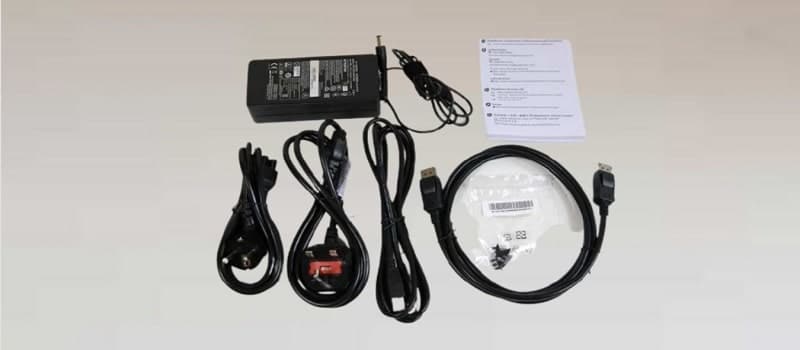
The bundle contains the following elements:
- ViewSonic Elite XG270QG Monitor
- VESA variant support arm 100 × 100 mm
- Legs
- 2x side visors for display
- DisplayPort
- USB Type-B – Type-A data cable
- European and British power connectors
- External power supply
- User manual
You will have noticed that it does not include an HDMI cable, which we do not understand very well since practically all monitors include it today.
Here Details About: Best Monitor for Color Grading.
The manufacturer is clear about one thing that the monitor’s maximum performance is achieved with DisplayPort, so avoid using HDMI.
Stand Design
The ViewSonic Elite XG270QG support is made up of two pieces: the base and the support arm. We quite liked this new design because it combines good stability thanks to the T-shaped support and great ergonomics, as we will see later.
Both elements are made of metal and painted matt black. The union of the two pieces is done simply by tightening a screw located at the base.
It is a fairly slender stand, with a noticeable curvature in its profile to ensure that the screen does not protrude too much from the legs.
In this sense, it is a base that takes up a lot of space, but it always stays behind the screen’s plane and will not hinder the user at any time.
The mechanism for raising and lowering the monitor is hydraulic and relatively stiff. The upper part ends with a curved element so that we can transport it more comfortably.
Also, in the middle area, we have a hole in the support to pass the cables through it. In general, it gives us excellent stability, although certainly, the legs are not the best looking on the market.
Speaking now about the screen support mechanism, it is the one that has all the necessary degrees of freedom for movement or positioning of the ViewSonic Elite XG270QG.
The clamping mode is a custom variant of the VESA 100X100 mm, in which we only have to dock the monitor with some upper and two lower tabs that fix it.
With a back button, we can separate the two elements again. This arm appears quite robust and reduces screen sway to almost zero on unstable surfaces.
Exterior Design
We will now see the fully assembled ViewSonic Elite XG270QG, which stands out above all for having practically non-existent frames as occurs with many of the current 27-inch monitors.
We only have the plastic courtesy edge that keeps the screen installed on the package and a lower frame of about 20 mm.
The side and top edges are integrated into the panel itself and occupy about 7mm.
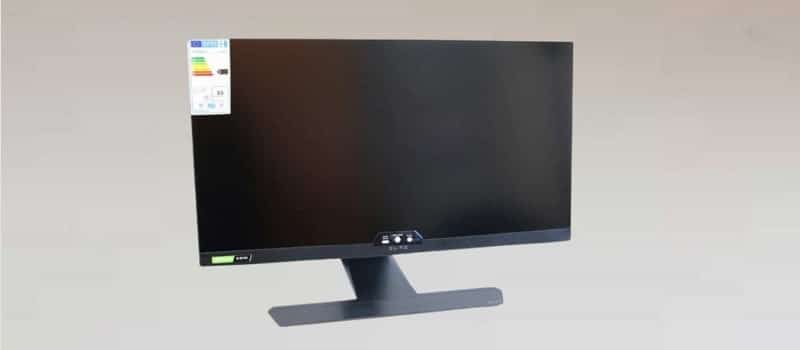
As we have commented, the screen protrudes a little from the plane that occupies the base, which is appreciated so that it does not get in the way.
However, it is certainly a monitor that occupies a lot of depth on our desk; we talk about 28-30 cm, depending on the screen’s position.
The anti-glare finish of the screen is also at an excellent level, blurring practically any element that affects it.
Viewsonic has thought of everything, and we see this reflected in elements such as the metal support placed at the back in a vertical “V” shape.
In it, we can hang the headphones or pass the cable from them so that it is not lying on the ground. Remember that the monitor has an extra audio output jack.
We also have side visors included for users who want extra precision in color and prevent reflections from entering the screen.
Also, the immersion is improved, or rather, the concentration in it, by isolating ourselves a little more from the outside.
Complete Ergonomics
We continue with the ergonomics offered by this ViewSonic Elite XG270QG, which stands out for being complete in the four available axes.
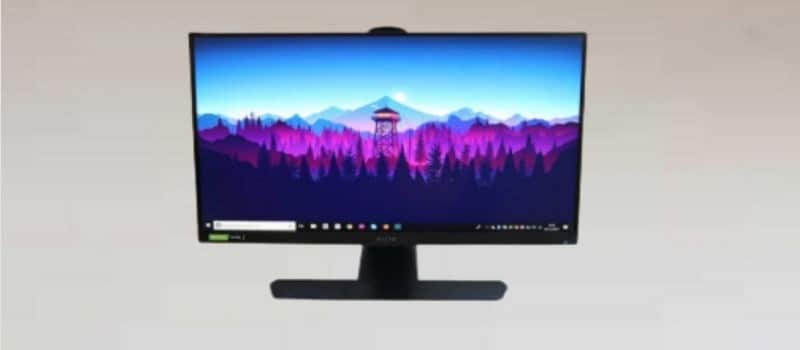
Being a 27-inch monitor, we still have space and the possibility of rotating it on its axis to place it vertically; in addition, this can be done both to the right and the left.
The arm’s length ensures that it does not rub against its base or table where it is installed.
The arm has a hydraulic system to move, allowing vertical movement in a range of 120 mm from the lowest to the highest position.
It is not the highest since others allow up to 130 mm, but it is more than enough for the user’s needs.
The clamping ball joint located directly on the support allows us to move in the two missing axes. The first of them corresponds to the possibility of orienting the panel frontally, which we can rotate down -5 ⁰ or up by about 20 ⁰.
The second is the Z-axis movement (sideways) in a range of 70⁰, 35 to the right and 35 to the left.
Connectivity
The connectivity of the ViewSonic Elite XG270QG is quite good, and all of it is concentrated in the lower rear area. It also has a trim that keeps the ports hidden that we can remove and put freely.
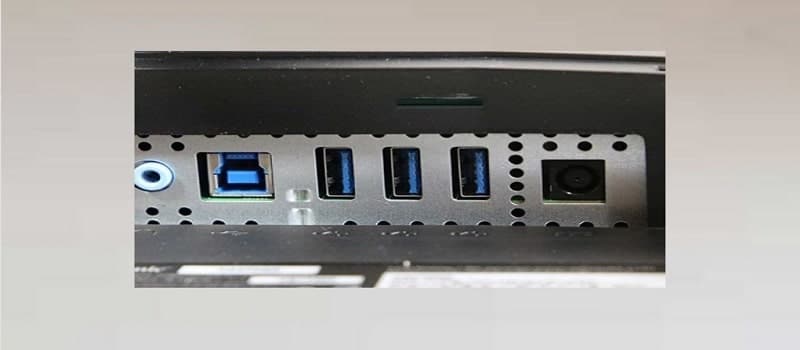
This is what we found:
- 3x USB 3.1 Gen1 Type-A
- USB 3.1 Gen1 Type-B (for data and configuration)
- 1x Display Port 1.2
- 1x HDMI 2.0
- 1x 3.5mm Mini-Jack for sound output
- Kensington slot for universal lock
- Jack type power connector
This time we have the DisplayPort 1.2 standard that provides enough bandwidth to transport the video signal at 2K with 8 bits + FRC and 165 Hz that this screen supports.
Lighting System
The ViewSonic Elite XG270QG review mentions this monitor lighting system: The manufacturer has also wanted to integrate a fairly complete RGB lighting system in this ViewSonic Elite XG270QG, to improve the image experience in very dark environments.
The system consists of two lighting zones with RGB LEDs. The first area is located at the rear, around the panel support element.
This offers us a strip in a hexagonal shape that does more than just be decorative since due to its power, we can consider it as backlighting if we are not far from a wall.
It is a little more powerful in the configuration of a double strip located under the lower frame of the screen, which affects the surface where it is placed to improve immersion.
If we have the monitor connected to the computer through the USB-B that it incorporates, we can manage this lighting through the Display Controller software.
We can download it directly from the official website, although it is still in the beta version and only allows lighting management.
At least in this model, we have not been able to choose between the different image modes that the equipment has enabled.
We hope that this will improve in successive updates since, for example in the XG270 model does allow us to make these types of modifications.
High-Quality Nano IPS Panel
One of the most differential aspects of this ViewSonic Elite XG270QG compared to other models is that it implements Nano IPS technology.
This variant of IPS technology installs a nanoparticle film on the panel to expand the range of colors displayed and their fidelity to reality.
In this way, it expands the coverage and improves the contrast ratio of the screen.
After this introduction about the new technology, it should be said that the manufacturer of this panel is none other than LG, a reference in the market in this type of solutions and that ViewSonic has managed to get the best out of it.
It offers us a 2K native resolution (2560x1440p), with a maximum brightness of 350 nits (cd / m 2 ), which does not support HDR and a typical contrast ratio of 1000: 1 and dynamic of 120M: 1.
The manufacturer estimates the lifespan of the LED backlight panel at a minimum of 30,000 hours.
Of course, we face a gaming monitor oriented to e-sport, or at least that is how we understand it, given its benefits.
And we have a maximum refresh rate of 165 Hz, which we can activate from the OSD panel, overclocking section.
Alongside it, we have a 1ms GTG response and dynamic refresh management via Nvidia G-Sync, which recently announced that it would release its code to combat AMD FreeSync.
The control system ensures the total absence of flicker or Flicker-Free and ghost image or Anti-Ghosting, which we anticipate.
Regarding the advantages that Nano IPS technology gives us in terms of color, the manufacturer ensures coverage of 98% DCI-P3 and a color depth of 10 interpolated bits, that is, 8 bits + FRC. Keep in mind that with G-Sync activated, we will be limited to the normal 8 bits.
The viewing angles are 178 or fulfilling them more than enough, as seen in the images. On this occasion, PiP or PbP modes have not been implemented, so we cannot simultaneously display two video sources.
The manufacturer does not give information about this panel’s calibration, so we suspect that it will be a standard as it does not have Pantone certification.
Yes, we have implemented a blue light filter to activate on the fly using quick access via joystick to control the configuration options.
Another point in favor is the good audio system that we have on the monitor, with 4 2W speakers grouped 2 in 2.
We have been surprised by its excellent quality in volume and frequency balance at the level of a few small desktop speakers.
Calibration and Performance Testing
We will analyze the calibration characteristics of the ViewSonic Elite XG270QG, verifying that the manufacturer’s technical parameters are met.
For this, we will use the X-Rite Colormunki Display colorimeter together with the DisplayCAL 3 and HCFR software for calibration and profiling, verifying these properties with the sRGB color space and also DCI-P3.
We have also used the Flickering and Ghosting tests on the Testufo page to verify that the monitor does not have this type of problem and tests while playing and performing benchmarks.
Flickering, Ghosting and Glow IPS
We have not detected any of those elements that would tarnish the pure performance and picture experience during the days that we have been testing this monitor.
We have verified through testudo and games like Metro Exodus that we do not have a flickering or burned-out effect.
The trail that can be seen in the test is not ghosting, but the change in pixel lighting during the transition, being the typical blur it is re-produced, and that the recording increases it slightly.
If you look at the reference images with ghosting, it is a different and non-existent effect. The same can be verified with Metro Exodus and other games, seeing that the lines’ sharpness is perfect and we do not have any aura around. Nvidia G-Sync and 165 Hz guarantee that we will not have any flickering in the image either.
Regarding the IPS glow effect in this panel, we can say that it is non-existent, observing in the image that the brightness is constant throughout the screen without producing areas of greater or lesser quantity.
Likewise, the absence of red color in the corners or areas near the frames is evident.
Contrast and brightness
For the gloss tests we have used 100% of its capacity.
We see some excellent records that meet the manufacturer’s specifications; although it is true, we expected a greater contrast for having nano IPS technology.
Regarding the Gamma value and color temperature, we are very close to what is considered ideal, that is, 2.2 and 6500 K.
Considering that we have not yet performed calibration, it has a good margin for improvement. Also, on the black level, it is very good if we consider that we are touching 400 nits of brightness.
Continuing with the brightness, a good uniformity is reflected in the 3 × 3 matrices that we have chosen for the tests at its maximum capacity.
In all cases, we are exceeding those 350 maximum nits, especially in the central zone that we even reach 421. However, there are notable differences with the extremes whose values are around 360-370 nits.
SRGB color space
This LG panel of the ViewSonic Elite XG270QG covers 100% of this color space without significant problems, something that we could anticipate considering its specifications.
However, it is revealed that its calibration is not perfect as it does not have a certification or include the corresponding report, having a mean Delta E of 2.63 and a maximum in the red tone.
Color graphics are generally good, although the gamma curve in this unit is quite wider on the grayscale, as we can see.
This is not a problem with the monitor, but with the calibration, easily remedied, as is the case with blue in the RGB graphics.
This is why the color temperature tends to be somewhat warmer than usual, not reaching 6500K.
DCI-P3 color space
We now continue with the DCI-P3 space, which has given us better results than the previous one, being a monitor calibrated under this space to create high definition multimedia content.
The coverage we have achieved is 95.5% on the triangle XY and practically 100% if the global is calculated. It would only need to extend its capacity in green tones a little to fulfill the space’s totality.
We see a notable improvement over the previous space regarding the calibration curves, both in gamma and luminance.
In general graphics such as color temperature or RGB, we continue to have the same values. This panel shows a high quality of blacks and whites thanks to this nanoparticle filter, translating into values that are very close to the ideal.
Calibration
The ViewSonic Elite XG270QG has been carried out with DisplayCAL in the monitor’s standard profile with a brightness of about 300 nits.
In this case, we have touched the green level in the outlining to adjust the three RGB tones and correct the low level of blue that came from the factory in this configuration.
Here we see the panel’s actual capacity, with a delta E reduced by an average of 0.39 in the DCI-P3 space and 0.61 in sRGB.
The improvement as we see has been remarkable, although, of course, our eyesight will not appreciate significant differences in most colors from good records.
With this, the color temperature has risen to a value closer to 6500K, noting a more neutral image.
We have also analyzed the ViewSonic Elite XG27, and we see notable differences between the benefits of one panel and another, ignoring their difference in resolution.
In the other model, we arrive much more closely at a good Delta E, and the color coverage is notably lower than the capacity of this nano IPS.
OSD Panel
We are already reaching the final stretch of this analysis of the ViewSonic Elite XG270QG; it is the turn to talk about the OSD panel, which is becoming more complete and with better accessibility for the user.
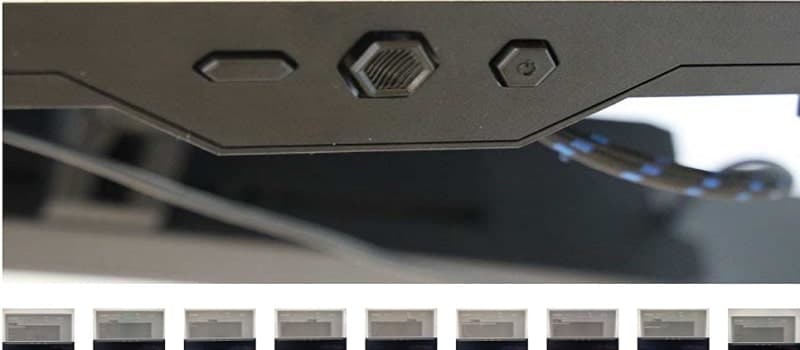
Control is done through a joystick located in the lower central area of the screen, perfectly accessible and with perfect control for both navigation and menu selection.
Although it is not strictly necessary, we have a second button that does the function of going back and exiting the menu.
It also allows you to activate or deactivate the blue light filter to the maximum instantly. The third button is used to turn the monitor on or off.
The menu is divided into five sections, and we can configure it in several languages and sizes as usual.
In the first menu, we find the different pre-configured image modes to choose the one that best suits us at all times, although curiously, we do not have any of them focused on design, such as a typical sRGB or a DCI-P3.
In the custom profiles, we can modify elements such as the black level, adaptive contrast, blue filter, etc.
The second menu takes care of the bulk of the screen configuration, being here the overclocking mode to achieve 165 Hz.
The rest we already know will be brightness, contrast, customizable saturation in 6 axes, color temperature, and some others.
The second menu is responsible for selecting the video input, which in this case, curiously, is not automatically selected. We must choose where we have connected the monitor.
The third menu is only for controlling the sound volume. Finally, we have generic options, such as the OSD configuration, crosshair selection, and turning the Elite RGB lighting on or off.
Use Experience
We finish as always by counting our experience of use with the ViewSonic Elite XG270QG and the days that we have been testing it.
Gaming: no ghosting or flickering
This panel’s quality is especially evident when we play since having 2K resolution, and such a high refresh rate makes it a very good versatility.
Once again, we understand that users who have high-end graphics cards will be the most suitable to buy this type of monitor since not many cards can move games at 2K and more than 90 Hz.
The reliability that the manufacturer gives in their products is very good, we have a VX3211-4K to do the hardware tests, and we are delighted with it.
And this one that we analyze is far superior in terms of quality since we have not seen ghosting at any time.
We also don’t see a hint of red color on it, and the flickering is fully controlled with that high refresh rate and Nvidia G-Sync to control it. Having such a fast screen makes everything go much more fluid.
We add the image and color quality that the Nano IPS panel gives us, which is fabulous. In this case, it is curious not to have implemented HDR support since the product is perfectly capable of it, and it would be something that would round it up.
It is something that, for example, the XG27 does have, although in a normal Full HD IPS panel.
Design
It is also a great panel for graphic design since we have a high resolution and a diagonal that makes us have very small pixels and great sharpness in the image.
Once again, the Nano IPS technology makes its color characteristics very good and almost at the Quantum DOT type level.
It just lacks a good factory calibration, although the manufacturer has focused on gaming, which is really what it’s built for.
But look at the excellent capacity it comes to after calibration, with Delta E lower than 1.
Final Words of ViewSonic Elite XG270QG Review
It is one of the best gaming monitors that we have tested and can buy for its price range. We can consider it as a direct competitor of the new AORUS, although in this case with Nano IPS technology that gives us an extra in color precision and image quality.
We have almost the entire gaming features package, with 165 Hz controlled thanks to Nvidia G-Sync technology, only 1 ms of response, and a resolution of 2560 x 1440p that is phenomenal for this 27-inch panel.
We highlight the absence of flickering and almost entirely ghosting except for very few occasions in which the color contrast is especially high.
We did not find either red color in the corners or the typical IPS glow of common IPS panels, one of the advantages of this and-particle technology.
We can say that the factory calibration is not excellent. As soon as we adjust it better, we will obtain incredible precision in the Delta E of colors as we have been able to verify. We only needed to implement HDR to round off the benefits.
The OSD panel has improved a lot, richer in options, and very fast to manage thanks to the joystick. This Elite series design has also been improved, with a high-quality metal base and a virtually frameless screen with excellent finishes.
And no less remarkable is the audio quality that it offers us with its 4 speakers—the less surprising, with a good level and even the presence of bass to enjoy multimedia content.
We finish with this monitor’s price; it is affordable if we consider that it offers the same or similar competition with a superior technology panel in terms of color and coverage.
Undoubtedly one of the roundest ViewSonic monitors for this final stretch of the year and far superior to, for example, the ELITE XG27.
Advantage
- Nano IPS Panel of high color quality.
- 165Hz, G-Sync, and 1ms response.
- Ideal for gaming with 27” and 2K.
- Good connectivity and OSD.
- Useful RGB lighting and a good sound system.
Disadvantages
- Does not have HDR.


